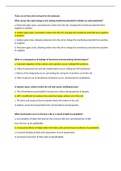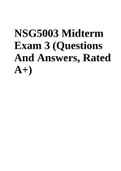NSG 5003 : Advanced pathophysiology (NSG5003)
South University
Page 3 out of 58 results
Sort by
NSG 5003 Midterm Exam 5 – Question And Answers Advanced Pathophysiology
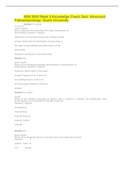
-
NSG 5003 Week 5 Knowledge Check Quiz: Advanced Pathophysiology: South University
- Exam (elaborations) • 3 pages • 2023
-
- $10.39
- + learn more
NSG 5003 Week 5 Knowledge Check Quiz: Advanced Pathophysiology: South University Question 1 (1 point) 5 out of 5 correct Saved Which statement best describes the major characteristic of bronchiolitis? Question 1 options: Destruction of lung parenchyma and collapse of distal airways Obstruction by eosinophilic mucous plugs in the upper airway Widespread inflammation of the bronchioles Extensive constriction of the bronchioles
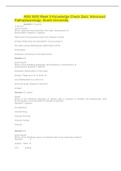
-
NSG 5003 Week 5 Knowledge Check Quiz: Advanced Pathophysiology: South University
- Exam (elaborations) • 3 pages • 2023
-
- $9.49
- + learn more
NSG 5003 Week 5 Knowledge Check Quiz: Advanced Pathophysiology: South University Question 1 (1 point) 5 out of 5 correct Saved Which statement best describes the major characteristic of bronchiolitis? Question 1 options: Destruction of lung parenchyma and collapse of distal airways Obstruction by eosinophilic mucous plugs in the upper airway Widespread inflammation of the bronchioles Extensive constriction of the bronchioles
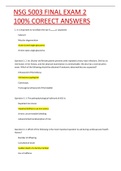
-
NSG 5003 FINAL EXAM 2 1OO% CORRECT ANSWERS
- Other • 66 pages • 2022
-
- $15.49
- + learn more
3. The pathophysiological hallmark of ACD is: 4. Which of the following is the most important question to ask during cardiovascular health history? 5. A 26-year-old, non-smoker, male presented to your clinic with SOB with exertion. This could be due to: 6. Which of the following dermatological conditionsresults from reactivation of the dormant varicella virus? 7. Mr. Jones is a 68-year-old retired Air Force pilot that has been diagnosed with prostate cance...
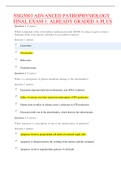
-
QUESTIONS AND ANSWERS ALREADY GRADED A PLUS
- Other • 19 pages • 2022
-
- $12.49
- + learn more
Question 1 (5 points) Which component of the cell produces hydrogen peroxide (H2O2) by using oxygen to remove hydrogen atoms from specific substrates in an oxidative reaction? Question 2 (5 points) What is a consequence of plasma membrane damage to the mitochondria? Question 3 (5 points) Which statement is a description of one of the characteristics of apoptosis? Question 4 (5 points) During cell injury caused by hypoxia, sodium and water move into the cell because: ...

-
NSG 5003 FINAL EXAM (LATEST Q&A)
- Exam (elaborations) • 20 pages • 2022
-
- $10.49
- + learn more
NSG 5003 FINAL EXAM (LATEST Q&A) This is a complete and an all-inclusive guide to NSG 5003 FINAL EXAM (LATEST Q&A). Which component of the cell produces hydrogen peroxide (H2O2) by using oxygen to remove hydrogen atoms from specific substrates in an oxidative reaction? Question 1 options: Lysosomes Peroxisomes Ribosomes Oxyhydrosomes Question 2 (5 points) What is a consequence of plasma membrane damage to the mitochondria? Question 2 options: Enzymatic digestion halts deoxyribonucleic...
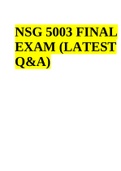
-
NSG 5003 FINAL EXAM 2021/2022 (LATEST Q&A)
- Exam (elaborations) • 20 pages • 2022
-
- $10.99
- + learn more
NSG 5003 FINAL EXAM 2021/2022 (LATEST Q&A) This is a complete and an all-inclusive guide to NSG 5003 FINAL EXAM. Which component of the cell produces hydrogen peroxide (H2O2) by using oxygen to remove hydrogen atoms from specific substrates in an oxidative reaction? Question 1 options: Lysosomes Peroxisomes Ribosomes Oxyhydrosomes Question 2 (5 points) What is a consequence of plasma membrane damage to the mitochondria? Question 2 options: Enzymatic digestion halts deoxyribonucleic a...
NSG 5003 Midterm Exam | NSG5003 Week 2 Patho Quiz | NSG 5003 WEEK 5 QUIZ And NSG5003 Midterm Exam

-
NSG 5003 Final Exam Questions and Answers
- Exam (elaborations) • 18 pages • 2022
-
- $10.99
- + learn more
NSG 5003 Final Exam Questions and Answers - South University. This is an inclusive guide to NSG 5003 Final Exam Questions and Answers. Which component of the cell produces hydrogen peroxide (H2O2) by using oxygen to remove hydrogen atoms from specific substrates in an oxidative reaction? Question 1 options: Lysosomes Peroxisomes Ribosomes Oxyhydrosomes Question 2 (5 points) What is a consequence of plasma membrane damage to the mitochondria? Question 2 options: Enzymatic digestion ha...

-
NSG 5003 Final Exam Questions and Answers - South University
- Exam (elaborations) • 18 pages • 2022
-
Available in package deal
-
- $11.99
- + learn more
This is an all inclusive guide to NSG 5003 Final Exam Questions and Answers. Which component of the cell produces hydrogen peroxide (H2O2) by using oxygen to remove hydrogen atoms from specific substrates in an oxidative reaction? Question 1 options: Lysosomes Peroxisomes Ribosomes Oxyhydrosomes Question 2 (5 points) What is a consequence of plasma membrane damage to the mitochondria? Question 2 options: Enzymatic digestion halts deoxyribonucleic acid (DNA) synthesis. Influx of calc...

Study stress? For sellers on Stuvia, these are actually golden times. KA-CHING! Earn from your study resources too and start uploading now. Discover all about earning on Stuvia

